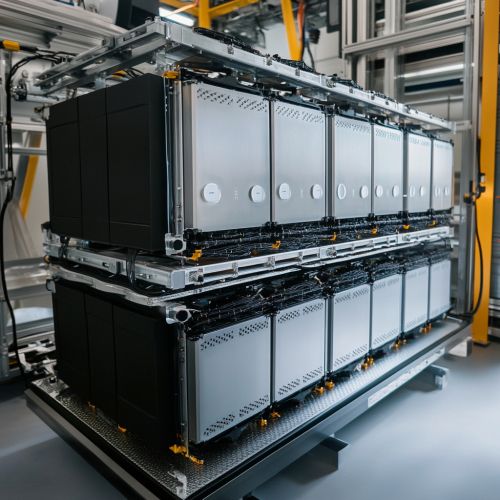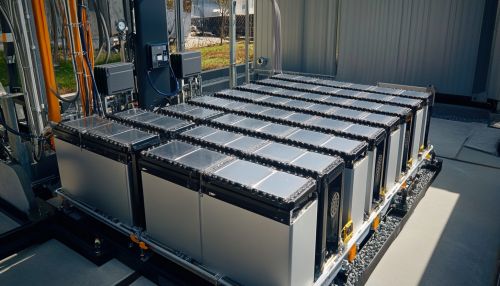Vanadium redox flow batteries
Introduction
Vanadium redox flow batteries (VRFBs) are a type of rechargeable flow battery that employs vanadium ions in different oxidation states to store chemical potential energy. These batteries are known for their ability to offer large-scale energy storage solutions, making them particularly suitable for applications in renewable energy systems, grid stabilization, and backup power supplies.
History and Development
The concept of the vanadium redox flow battery was first proposed by NASA researchers in the 1970s. However, significant advancements were made in the 1980s by Maria Skyllas-Kazacos and her team at the University of New South Wales, Australia. They developed the first practical VRFB system, which utilized vanadium's unique ability to exist in four different oxidation states, allowing for efficient energy storage and release.
Working Principle
VRFBs operate based on the redox reactions of vanadium ions in an electrolyte solution. The battery consists of two tanks containing the electrolyte solutions, which are pumped through a cell stack where the electrochemical reactions occur. The cell stack is divided into two half-cells by a proton exchange membrane (PEM). The electrolyte in the positive half-cell contains vanadium in the +5 and +4 oxidation states, while the electrolyte in the negative half-cell contains vanadium in the +3 and +2 oxidation states.
During the charging process, vanadium ions in the positive half-cell are oxidized from V(IV) to V(V), while vanadium ions in the negative half-cell are reduced from V(III) to V(II). During discharge, the reverse reactions occur, releasing the stored energy.


Electrolyte Composition
The electrolyte in VRFBs typically consists of vanadium dissolved in sulfuric acid. The concentration of vanadium ions and the acidity of the solution are critical factors that influence the battery's performance, including its energy density, efficiency, and lifespan. Researchers have explored various additives and alternative solvents to enhance the electrolyte's properties and reduce costs.
Cell Stack Design
The cell stack is a crucial component of VRFBs, comprising multiple cells connected in series or parallel to achieve the desired voltage and capacity. Each cell consists of bipolar plates, current collectors, and electrodes, separated by the proton exchange membrane. The design and materials used for these components significantly impact the battery's efficiency, durability, and cost.
Advantages of VRFBs
VRFBs offer several advantages over other types of batteries, including:
- **Scalability**: The energy capacity of VRFBs can be easily scaled by increasing the size of the electrolyte tanks, making them ideal for large-scale energy storage applications.
- **Long Cycle Life**: VRFBs can withstand tens of thousands of charge-discharge cycles with minimal degradation, providing a long operational lifespan.
- **Safety**: VRFBs are inherently safe, as they operate at ambient temperatures and pressures, and the electrolyte is non-flammable.
- **Flexibility**: The power and energy capacity of VRFBs can be independently optimized, allowing for flexible system design.
Challenges and Limitations
Despite their advantages, VRFBs face several challenges that need to be addressed to achieve widespread adoption:
- **Cost**: The high cost of vanadium and the complexity of the cell stack design contribute to the overall cost of VRFB systems.
- **Energy Density**: VRFBs have lower energy density compared to other battery technologies, such as lithium-ion batteries, limiting their use in applications where space and weight are critical factors.
- **Electrolyte Management**: The management of the electrolyte, including its storage, pumping, and maintenance, adds to the system's complexity and operational costs.
Applications
VRFBs are well-suited for various applications, including:
- **Renewable Energy Integration**: VRFBs can store excess energy generated from renewable sources, such as solar and wind, and release it when needed, helping to stabilize the grid and ensure a reliable power supply.
- **Grid Stabilization**: VRFBs can provide ancillary services, such as frequency regulation and load leveling, to maintain grid stability and prevent blackouts.
- **Backup Power**: VRFBs can serve as backup power systems for critical infrastructure, such as hospitals, data centers, and telecommunications facilities, ensuring uninterrupted power supply during outages.
Future Prospects
Research and development efforts are ongoing to address the challenges and improve the performance of VRFBs. Advances in materials science, electrolyte chemistry, and cell stack design are expected to enhance the efficiency, reduce costs, and increase the energy density of VRFBs. Additionally, the development of hybrid systems that combine VRFBs with other energy storage technologies could further expand their applications and benefits.
See Also
References
- Skyllas-Kazacos, M., et al. "Vanadium Redox Battery." Journal of Power Sources, vol. 22, no. 3, 1988, pp. 89-98.
- Weber, A. Z., et al. "Redox Flow Batteries: A Review." Journal of Applied Electrochemistry, vol. 41, no. 10, 2011, pp. 1137-1164.
- Ponce de León, C., et al. "Redox Flow Cells for Energy Conversion." Journal of Power Sources, vol. 160, no. 1, 2006, pp. 716-732.
